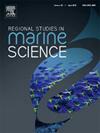Population structure of the deep coral Desmophyllum dianthus associated with a lost fishing gear/ line
IF 2.1
4区 环境科学与生态学
Q3 ECOLOGY
引用次数: 0
Abstract
The habitats created by cold-water corals (CWC) are among the most complex in the deep ocean and they are considered biodiversity hotspots with incalculable biological richness. However, distribution of these coral populations on Mediterranean platforms remains relatively unknown and only six provinces with certain density of CWC are recognised to date. During an INTEMARES survey carried off the southeast Iberian Peninsula in 2020, a lost longline was recovered in one of the hauls using a hard bottom dredge. The abandoned gear revealed populations of CWC, mainly Desmophyllum pertusum (Linnaeus, 1758) and Desmophyllum dianthus (Esper, 1794). The present study aims to contribute providing information on the coral D. dianthus in the Mediterranean and extending the distribution range of CWC in the south-eastern Iberian Peninsula by means of a population analysis of the individuals found on the recovered gear. Abundance and density of D. dianthus observed on the gear were higher than reported in other CWC populations in the Mediterranean Sea. Furthermore, in light of the results, there is potential for more unidentified populations of D. dianthus and other CWC species to be established in the area. Results also confirm the role of unwanted anthropogenic debris as a substrate for sessile organisms.
与丢失渔具/钓线有关的深珊瑚石竹的种群结构
冷水珊瑚(CWC)创造的栖息地是深海中最复杂的栖息地之一,它们被认为是生物多样性的热点,具有不可估量的生物丰富性。然而,这些珊瑚种群在地中海平台上的分布仍然相对未知,迄今为止只有六个省份被确认有一定的CWC密度。2020年,在伊比利亚半岛东南部进行的一项调查中,使用硬底挖泥船在一次运输中找到了一根丢失的延绳钓。在废弃的齿轮上发现了CWC的种群,主要是百叶石竹(Linnaeus, 1758)和石竹石竹(Esper, 1794)。本研究旨在通过对回收渔具上发现的珊瑚进行种群分析,为地中海的石竹珊瑚提供信息,并扩大CWC在伊比利亚半岛东南部的分布范围。在该渔具上观察到的石竹的丰度和密度高于地中海其他CWC种群的报道。此外,根据研究结果,有可能在该地区建立更多身份不明的石竹和其他CWC物种。结果还证实了不需要的人为碎片作为无底生物的底物的作用。
本文章由计算机程序翻译,如有差异,请以英文原文为准。
求助全文
约1分钟内获得全文
求助全文
来源期刊

Regional Studies in Marine Science
Agricultural and Biological Sciences-Ecology, Evolution, Behavior and Systematics
CiteScore
3.90
自引率
4.80%
发文量
336
审稿时长
69 days
期刊介绍:
REGIONAL STUDIES IN MARINE SCIENCE will publish scientifically sound papers on regional aspects of maritime and marine resources in estuaries, coastal zones, continental shelf, the seas and oceans.
 求助内容:
求助内容: 应助结果提醒方式:
应助结果提醒方式:


